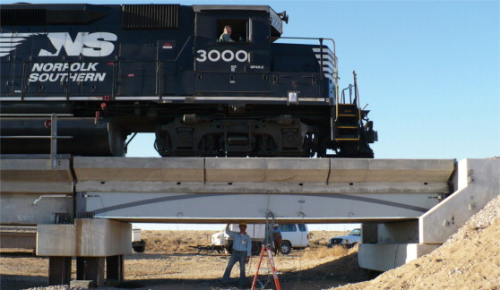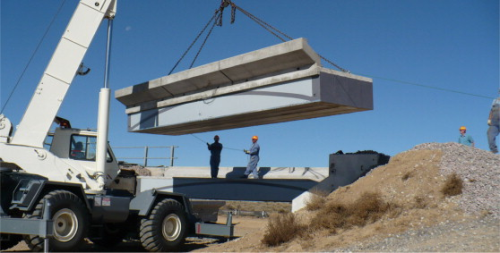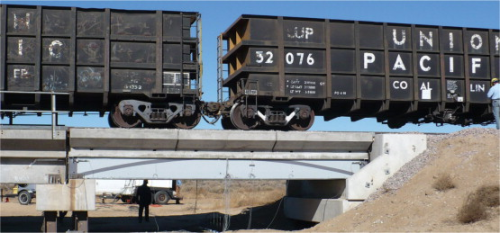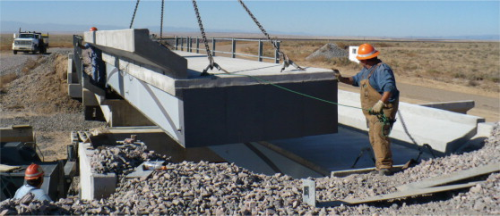



The live load test was conducted on the 2.7 mile FAST (Facility for Accelerated Service Testing) Loop at the Transportation Technology Center (TTC) near Pueblo, Colorado, USA. This transportation research and testing facility is operated by TTCI, a subsidiary of the Association of American Railroads. According to John Hillman, Senior Associate with Teng & Associates in Chicago and founder and president of HC Bridge Company LLC, the structural engineer for the project, the bridge supporting the locomotive is a 30 ft span comprised of eight hybrid-composite beams.
“I’ve always been fascinated by the simplicity and elegance of the load paths in arch structures,” says Hillman. “When I was introduced to vacuum assisted resin transfer methods (VARTM) for composite manufacturing, it seemed logical to me to combine this versatility with the strength and economy of conventional building materials, yet still benefit from the lightweight and corrosion resistant nature of composite materials.”
With this in mind, Hillman set out in the mid-1990s to design and build a lighter yet more durable bridge structure. Today, these beams, known as the Hillman-Composite Beam (HCB) are designed to be stronger, lighter and more corrosion resistant than the standard concrete and steel beams traditionally used in infrastructure applications.
“The response of the bridge matched exactly the predicted strains and displacements calculated in accordance with the limits specified in the AREMA [American Railway Engineering and Maintenance-of-Way Association] design codes,” says Hillman. “With the performance of the HCB validated and recognised by the rail community, the next step is production of a prototype for extended testing in Pueblo. Our ultimate goal is for the HCB to become the standard bridge technology for revenue service on the Class 1 railroads.”
In its simplest form, the HCB is made up of three components: shell; compression reinforcement; and tension reinforcement. The compression reinforcement consists of self-consolidated concrete that is pumped into a profiled conduit within the beam shell. The tension reinforcement consists of Hardwire® steel reinforcing fabrics that run along the bottom flanges of the beams.
After patenting the concept, Hillman turned to the University of Delaware – Center for Composite Materials (UD-CCM) for support in fabrication research and structural validation of the beam. Several other industrial partners also contributed to the project, including: Owens Corning, which provided its Advantex® Flow-Tex™ quad-weave reinforcement material for the resin infusion process; Ashland Specialty Chemicals, which supplied Derakane Momentum resins; the Elliott Company, which provided polyiso foam; and Hardwire LLC, whose steel reinforcement was used in the beams.
Essentially, the beam functions like a tied arch in a glass box and Hillman used this principle to improve load performance and decrease weight. The concrete arch is tied at each end with multiple layers of Hardwire steel reinforcements, which run along the bottom flange. The high-strength steel fabrics – which consist of thin, twisted, 450 000 psi, high-tensile steel cords – are 11 times stronger than a typical steel plate. Compared to high-strength carbon fibre, which is typically used for reinforcing structures, this solution is available at a fraction of the cost.
The beam is formed by infusing Owens Corning Flow-Tex reinforcement with DERAKANE 411-350 Momentum resin to create a shell wrapped around a foam core comprised of Elliott's ELFOAM® polyiso foam. After removal from the mould, the shell is filled with self-consolidating concrete. Much less concrete is used in this method than in standard pre-stressed concrete girders.
A consortium of Class 1 Railroads –including BNSF Railway, Canadian National, Canadian Pacific, Norfolk Southern and Union Pacific – shouldered the substantial cost of the live test.
"This was evidence that the railroad community is interested in the benefits of this technology,” reports Hillman.
He credits TTCI's Principal Engineer Duane Otter with pushing the initiative and overseeing the testing operation in Colorado. The live train tests were the final objective of a project called the IDEA (Innovations Deserving Exploratory Analysis) HSR (High Speed Rail) programme, which is funded by the Federal Railroad Administration and managed by the Transportation Research Board (TRB).
“Fifty years ago, we started using pre-stressed concrete for railroad bridges and that was considered new technology at the time,” says Otter. “Since that time, they have become a mainstay for railroad bridge construction. Looking ahead, we see the HCB technology as having the potential to become a new mainstay.”
Chuck Taylor, Program Officer for the High-Speed Rail IDEA Program, concurs.
“Initial development of the HCB was one of the most successful projects funded by the High-Speed Rail IDEA HSR Program,” he says. “The commercial potential of this beam technology is evidenced by the fact that five major railroads funded, on their own, the installation and operational testing of an HCB bridge at the Transportation Technology Center in Pueblo, Colo.”
Plans are also in place for the technology to be tested on two highway bridges this year – a 58 ft span in Illinois and a 36 ft span in New Jersey. The bridges will be constructed with project funding provided by the Federal Highway Administration through the IBRD (Innovative Bridge Research and Design) Program. Fabrication of the Illinois bridge will begin this month.
“I see the HCB technology continuing to evolve with each new installation as well as becoming more cost-competitive with each refinement,” said Hillman. “The success of the HCB could result in a paradigm shift in the bridge industry. The HCB represents a logical progression of bridge technology using conventional materials in harmony with advanced composite materials to create bridging solutions that address the future needs of our aging infrastructure.”
HC Bridge Company LLC specialises in the development and commercialisation of composite bridge technology that accelerates bridge construction and provides structures designed to offer service lives beyond 100 years.
